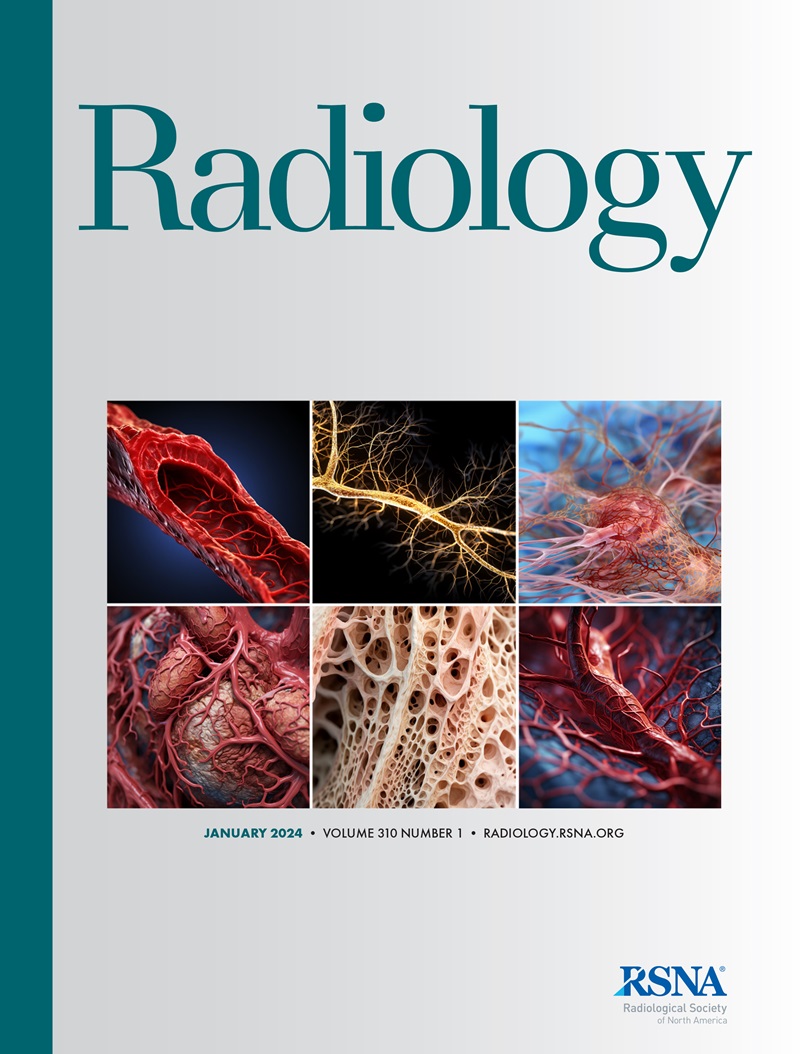Reproducibility and Repeatability of US Shear-Wave and Transient Elastography in Nonalcoholic Fatty Liver Disease.
Theodore T Pierce,Arinc Ozturk,Sarah P Sherlock,Guilherme Moura Cunha,Xiaohong Wang,Qian Li,David Hunt,Michael S Middleton,Marian Martin,Kathleen E Corey,Hannah Edenbaum,Sudha S Shankar,Helen Heymann,Tania N Kamphaus,Roberto A Calle,Yesenia Covarrubias,Rohit Loomba,Nancy A Obuchowski,Arun J Sanyal,Claude B Sirlin,Kathryn J Fowler,Anthony E Samir
求助PDF
{"title":"Reproducibility and Repeatability of US Shear-Wave and Transient Elastography in Nonalcoholic Fatty Liver Disease.","authors":"Theodore T Pierce,Arinc Ozturk,Sarah P Sherlock,Guilherme Moura Cunha,Xiaohong Wang,Qian Li,David Hunt,Michael S Middleton,Marian Martin,Kathleen E Corey,Hannah Edenbaum,Sudha S Shankar,Helen Heymann,Tania N Kamphaus,Roberto A Calle,Yesenia Covarrubias,Rohit Loomba,Nancy A Obuchowski,Arun J Sanyal,Claude B Sirlin,Kathryn J Fowler,Anthony E Samir","doi":"10.1148/radiol.233094","DOIUrl":null,"url":null,"abstract":"Background US shear-wave elastography (SWE) and vibration-controlled transient elastography (VCTE) enable assessment of liver stiffness, an indicator of fibrosis severity. However, limited reproducibility data restrict their use in clinical trials. Purpose To estimate SWE and VCTE measurement variability in nonalcoholic fatty liver disease (NAFLD) within and across systems to support clinical trial diagnostic enrichment and clinical interpretation of longitudinal liver stiffness. Materials and Methods This prospective, observational, cross-sectional study (March 2021 to November 2021) enrolled adults with NAFLD, stratified according to the Fibrosis-4 (FIB-4) index (≤1.3, >1.3 and <2.67, ≥2.67), at two sites to assess SWE with five US systems and VCTE with one system. Each participant underwent 12 elastography examinations over two separate days within 1 week, with each day's examinations conducted by a different operator. VCTE and SWE measurements were reported in units of meters per second. The primary end point was the different-day, different-operator reproducibility coefficient (RDCDDDO) pooled across systems for SWE and individually for VCTE. Secondary end points included system-specific RDCDDDO, same-day, same-operator repeatability coefficient (RCSDSO), and between-system same-day, same-operator reproducibility coefficient. The planned sample provided 80% power to detect a pooled RDCDDDO of less than 35%, the prespecified performance threshold. Results A total of 40 participants (mean age, 60 years ± 10 [SD]; 24 women) with low (n = 17), intermediate (n = 15), and high (n = 8) FIB-4 scores were enrolled. RDCDDDO was 30.7% (95% upper bound, 34.4%) for SWE and 35.6% (95% upper bound, 43.9%) for VCTE. SWE system-specific RDCDDDO varied from 24.2% to 34.3%. The RCSDSO was 21.0% for SWE (range, 13.9%-35.0%) and 19.6% for VCTE. The SWE between-system same-day, same-operator reproducibility coefficient was 52.7%. Conclusion SWE met the prespecified threshold, RDCDDDO less than 35%, with VCTE having a higher RDCDDDO. SWE variability was higher between different systems. These estimates advance liver US-based noninvasive test qualification by (a) defining expected variability, (b) establishing that serial examination variability is lower when performed with the same system, and (c) informing clinical trial design. ClinicalTrials.gov Identifier NCT04828551 © RSNA, 2024 Supplemental material is available for this article.","PeriodicalId":20896,"journal":{"name":"Radiology","volume":null,"pages":null},"PeriodicalIF":12.1000,"publicationDate":"2024-09-01","publicationTypes":"Journal Article","fieldsOfStudy":null,"isOpenAccess":false,"openAccessPdf":"","citationCount":"0","resultStr":null,"platform":"Semanticscholar","paperid":null,"PeriodicalName":"Radiology","FirstCategoryId":"3","ListUrlMain":"https://doi.org/10.1148/radiol.233094","RegionNum":1,"RegionCategory":"医学","ArticlePicture":[],"TitleCN":null,"AbstractTextCN":null,"PMCID":null,"EPubDate":"","PubModel":"","JCR":"Q1","JCRName":"RADIOLOGY, NUCLEAR MEDICINE & MEDICAL IMAGING","Score":null,"Total":0}
引用次数: 0
引用
批量引用
Abstract
Background US shear-wave elastography (SWE) and vibration-controlled transient elastography (VCTE) enable assessment of liver stiffness, an indicator of fibrosis severity. However, limited reproducibility data restrict their use in clinical trials. Purpose To estimate SWE and VCTE measurement variability in nonalcoholic fatty liver disease (NAFLD) within and across systems to support clinical trial diagnostic enrichment and clinical interpretation of longitudinal liver stiffness. Materials and Methods This prospective, observational, cross-sectional study (March 2021 to November 2021) enrolled adults with NAFLD, stratified according to the Fibrosis-4 (FIB-4) index (≤1.3, >1.3 and <2.67, ≥2.67), at two sites to assess SWE with five US systems and VCTE with one system. Each participant underwent 12 elastography examinations over two separate days within 1 week, with each day's examinations conducted by a different operator. VCTE and SWE measurements were reported in units of meters per second. The primary end point was the different-day, different-operator reproducibility coefficient (RDCDDDO) pooled across systems for SWE and individually for VCTE. Secondary end points included system-specific RDCDDDO, same-day, same-operator repeatability coefficient (RCSDSO), and between-system same-day, same-operator reproducibility coefficient. The planned sample provided 80% power to detect a pooled RDCDDDO of less than 35%, the prespecified performance threshold. Results A total of 40 participants (mean age, 60 years ± 10 [SD]; 24 women) with low (n = 17), intermediate (n = 15), and high (n = 8) FIB-4 scores were enrolled. RDCDDDO was 30.7% (95% upper bound, 34.4%) for SWE and 35.6% (95% upper bound, 43.9%) for VCTE. SWE system-specific RDCDDDO varied from 24.2% to 34.3%. The RCSDSO was 21.0% for SWE (range, 13.9%-35.0%) and 19.6% for VCTE. The SWE between-system same-day, same-operator reproducibility coefficient was 52.7%. Conclusion SWE met the prespecified threshold, RDCDDDO less than 35%, with VCTE having a higher RDCDDDO. SWE variability was higher between different systems. These estimates advance liver US-based noninvasive test qualification by (a) defining expected variability, (b) establishing that serial examination variability is lower when performed with the same system, and (c) informing clinical trial design. ClinicalTrials.gov Identifier NCT04828551 © RSNA, 2024 Supplemental material is available for this article.
美国非酒精性脂肪肝剪切波和瞬态弹性成像的再现性和重复性。
背景 美国剪切波弹性成像(SWE)和振动控制瞬态弹性成像(VCTE)可评估肝脏硬度,这是纤维化严重程度的一个指标。然而,有限的重现性数据限制了它们在临床试验中的应用。目的 估计非酒精性脂肪肝(NAFLD)在系统内和系统间的 SWE 和 VCTE 测量变异性,以支持临床试验诊断的丰富性和纵向肝脏硬度的临床解释。材料和方法 这项前瞻性、观察性、横断面研究(2021 年 3 月至 2021 年 11 月)在两个地点招募了非酒精性脂肪肝成人患者,根据纤维化-4 (FIB-4) 指数(≤1.3,>1.3 和<2.67,≥2.67)进行分层,用五种 US 系统评估 SWE,用一种系统评估 VCTE。每位参与者在一周内分两天接受了 12 次弹性成像检查,每天的检查由不同的操作员进行。VCTE 和 SWE 测量值以米/秒为单位进行报告。主要终点是不同日期、不同操作员的可重复性系数(RDCDDDO),SWE 为不同系统的集合,VCTE 为单个系统的集合。次要终点包括系统特异性 RDCDDDO、同日同操作者重复性系数 (RCSDSO) 以及系统间同日同操作者重复性系数。计划中的样本提供了 80% 的功率来检测小于 35% 的集合 RDCDDDO,这是预设的性能阈值。结果 共有 40 名参与者(平均年龄为 60 岁 ± 10 [SD];24 名女性)参加了此次研究,他们的 FIB-4 评分分别为低分(17 人)、中分(15 人)和高分(8 人)。SWE的RDCDDDO为30.7%(95%上限,34.4%),VCTE为35.6%(95%上限,43.9%)。全部门教育系统的 RDCDDDO 从 24.2% 到 34.3% 不等。全部门教育的 RCSDSO 为 21.0%(范围为 13.9%-35.0%),非全部门教育的 RCSDSO 为 19.6%。SWE系统间同一天、同一操作者的可重复性系数为52.7%。结论 SWE 符合预设阈值,即 RDCDDDO 小于 35%,而 VCTE 的 RDCDDDO 较高。不同系统之间的 SWE 变异性更高。这些估算通过(a)定义预期变异性,(b)确定使用同一系统进行连续检查时变异性较低,以及(c)为临床试验设计提供信息,从而推动了基于美国肝脏的无创检验鉴定。ClinicalTrials.gov Identifier NCT04828551 © RSNA, 2024 本文有补充材料。
本文章由计算机程序翻译,如有差异,请以英文原文为准。


